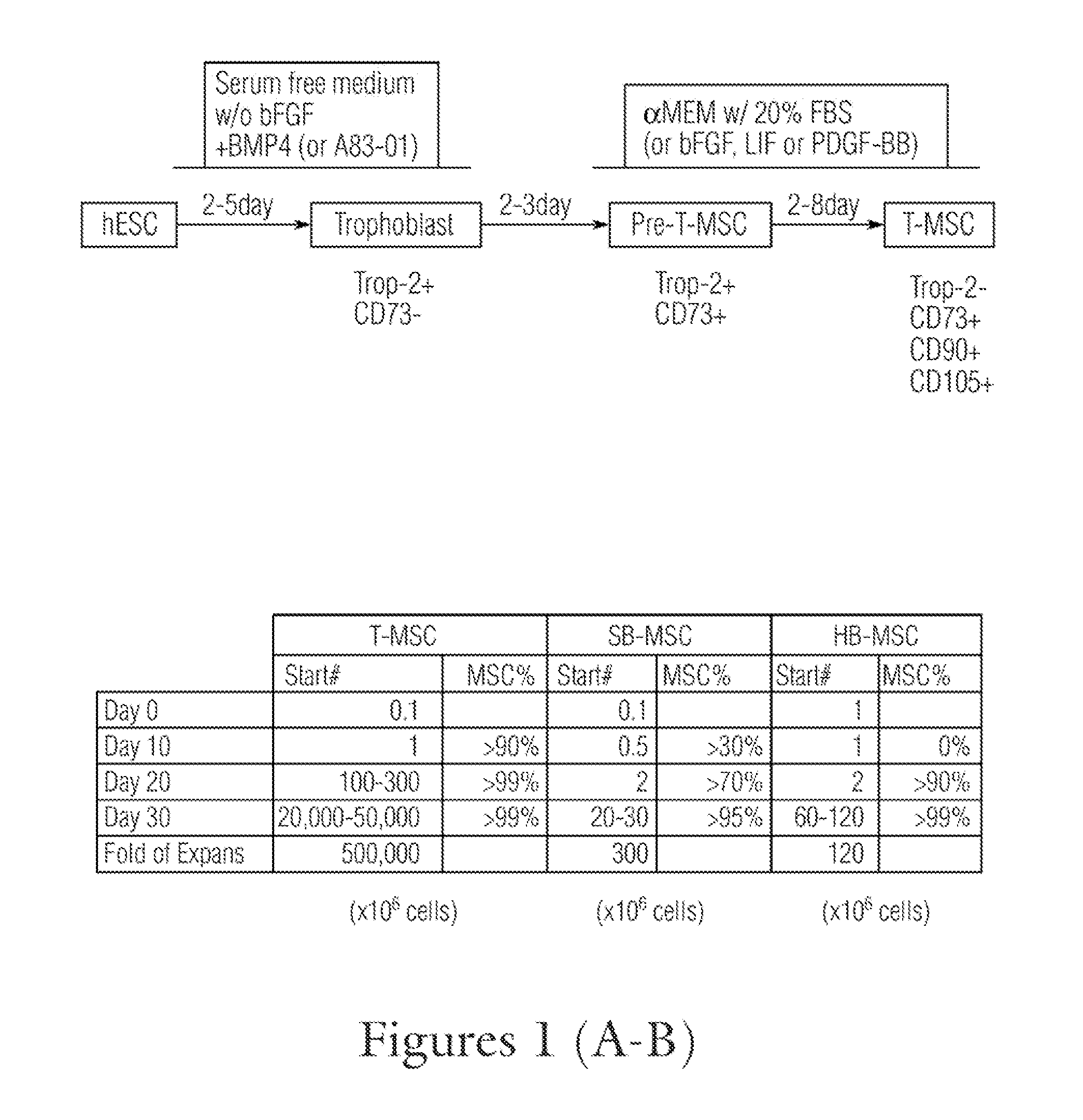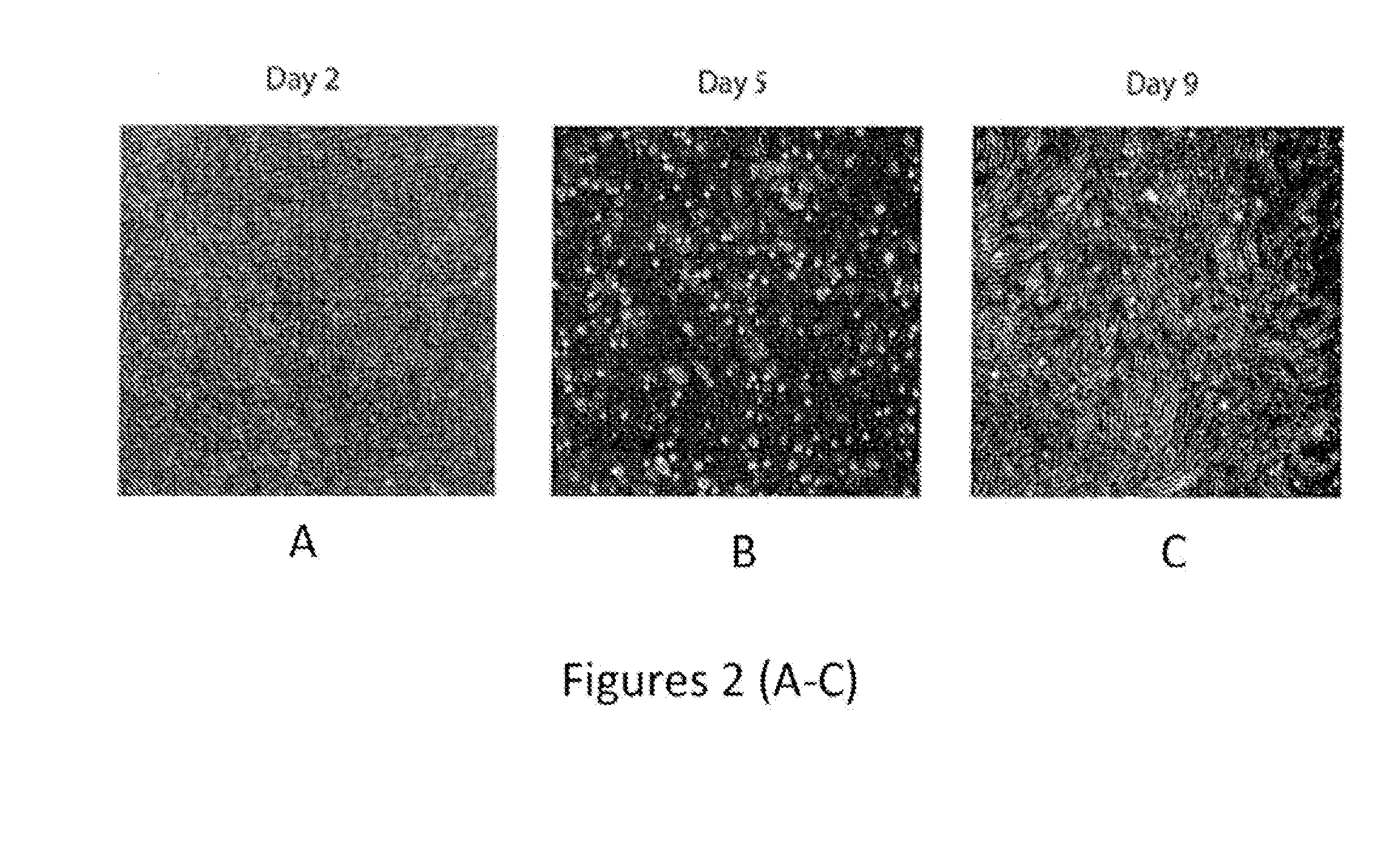Mesenchymal-like stem cells derived from human embryonic stem cells, methods and uses thereof
a technology of embryonic stem cells and stem cells, applied in the field of embryonic stem cell derived stem cells, can solve the problems of wasting resources, wasting resources, and current methods that cannot conduct such differentiation in an efficient manner, and achieves the effects of high yield, high yield, and efficient generation of mscs
- Summary
- Abstract
- Description
- Claims
- Application Information
AI Technical Summary
Benefits of technology
Problems solved by technology
Method used
Image
Examples
example 1
Derivation of T-MSC Material and Methods
[0343]The following reagents and materials were obtained from the below-described sources:[0344]Customed mTeSR1 Medium: Stem Cell Technology, Inc.[0345]BMP4: Stemgent or other vendors[0346]SB431542: Cayman Chemical or other vendors[0347]A83-01: Stemgent or other vendors.[0348]ALK5 inhibitor: Stemgent or other Vendors[0349]DMEM / F12: GIBCO Life Technologies[0350]alpha-MEM: GIBCO Life Technologies[0351]Fetal Bovine Serum: GIBCO Life Technologies or other vendors
[0352]CT2 hESC line derived at the University of Connecticut Stem Cell Core was cultured for two passages on irradiated mouse embryonic fibroblast (MEF) as feeders. The hESCs were then split on plates coated with Matrigel (BD Biosciences, San Jose, Calif.) and cultured in mTeSR1 (Ludwig et al., 2006) (Stem Cell Technologies, Vancouver, Canada). ESI-017, ESI-051, ESI-053, ESI-049, and ESI-35 human embryonic stem cells were purchased from BioTime, Inc. (CA).
[0353]Derivation of T-MSC
[0354]As ...
example 2
Characterization of T-MSC cells
[0365]The T-MSC cells obtained in Example 1 were further analyzed using flow cytometry immunofluorescence staining.
[0366]Materials and Methods
[0367]Flow cytometry staining was used to characterize the T-MSCs. Cells were washed and blocked with 2% BSA in PBS, and stained with antibodies for various cell surface markers Trop-2 (Trp-2, eBioscience), CD31. CD34, CD29. CD73, CD90, CD105, CD44, CD45, CD146, CD166, HLA-ABC, HLA-DR, HLA-G (BD Bioscience or eBioscience) by following the manufacturers' instructions. Data were collected on FACS LSR II Flow Cytometer using FACSDiva software (BD Bioscience). Post-acquisition analysis was performed with the FlowJo software (Treestar).
[0368]Results
[0369]The attached cells obtained from Day 2 trophoblast, Day 5 pre-T-MSC and Day 9 T-MSC were stained with CD73 and Trop-2. The trophoblast cells only expressed high levels of Trop-2 (greater than 95%), but less than 1% of CD73 (FIG. 3A); the pre-T-MSC at day 5 has more th...
example 3
T-MSCs have a Stronger Inhibition on T Cell Functions In Vitro than BM-MSC
[0371]hEs-MSCs and BM-MSCs were compared for their ability to inhibit T cell proliferation in vitro following antigen stimulation.
[0372]Materials and Methods
[0373]Culture of BM-MSCs
[0374]BM-MSCs were derived from BM mononuclear cells (BMMNCs) or obtained from AllCells, Inc. (Alameda) and Lonza (Basel, Switzerland) BMMNCs. For derivation, BMMNCs were thawed and plated onto tissue culture plastic dishes in □MEM+20% FBS. Adherent cells began to appear within the first 4-5 days and fed every 3 days until day ˜10-12, when cells were harvested and replated at 3,000-5,000 cells / cm2.
[0375]The in vitro assay for T cell proliferation was performed using lymphocytes isolated from mouse peripheral lymph nodes. These lymphocytes were labeled with 5 μM of carboxyfluorescein succinimidyl ester (CFSE) to track their proliferation by monitoring CFSE dilution in their daughter cells, for 10 minutes at 37° C. 10,000 T-MSCs or BM...
PUM
| Property | Measurement | Unit |
|---|---|---|
| time | aaaaa | aaaaa |
| time | aaaaa | aaaaa |
| concentration | aaaaa | aaaaa |
Abstract
Description
Claims
Application Information
 Login to View More
Login to View More - R&D
- Intellectual Property
- Life Sciences
- Materials
- Tech Scout
- Unparalleled Data Quality
- Higher Quality Content
- 60% Fewer Hallucinations
Browse by: Latest US Patents, China's latest patents, Technical Efficacy Thesaurus, Application Domain, Technology Topic, Popular Technical Reports.
© 2025 PatSnap. All rights reserved.Legal|Privacy policy|Modern Slavery Act Transparency Statement|Sitemap|About US| Contact US: help@patsnap.com



